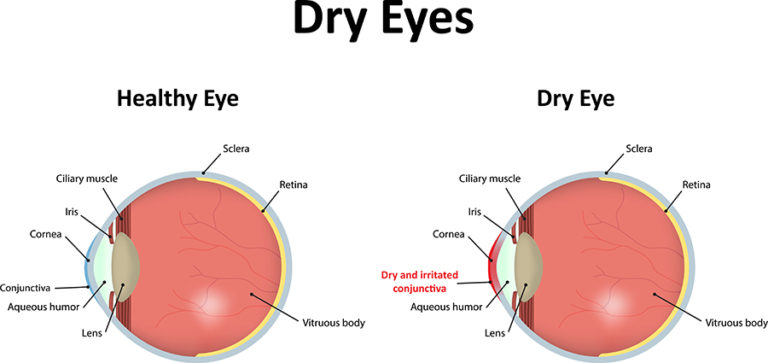Dry eye is a chronic condition that occurs when there is an insufficient quantity or unhealthy quality of tears to keep the eye lubricated and nourished.
What is the tear film?
The tear film is the fluid that lubricates and provides protection for the eyes. It is not only an important part of the function of the eye but also for vision. With each blink, the tear film is spread over the eye surface making it smooth and clear.
The tear film is made up of 3 layers:
- An inner layer (mucin)
- A middle layer (aqueous/watery)
- An outer layer (oily)
The inner layer is comprised of mucin which is produced by the conjunctiva (transparent skin over the white portion of the eye.) The mucin or mucous helps the aqueous (watery) layer to spread evenly over the eyes.
The middle (aqueous/watery) layer is the thickest portion of the tear film. This layer is produced by the lacrimal glands and accessory glands. This layer functions to help flush out any debris, dust or irritants that may get into the eye.
The outer/superficial layer is the oily layer. It is produced by the meibomian glands and glands of zeis. The primary purpose of this layer is to help to reduce the evaporation of the tears.

What is dry eye syndrome?
Dry eye syndrome (DES) also known as dry eye disease (DED) or keratoconjunctivitis (KCS) has to do with the eye’s inability to keep itself lubricated naturally. If this function is disrupted it can lead to challenges in the eye’s ability to protect itself from infection or injury.
What is the impact of dry eye syndrome?
It is believed that approximately 20-25 million Americans are affected by dry eyes. Unfortunately women are more prone than men. More than 3 million American women and 1.5 million American men over the age of 50 have dry eyes. The likelihood of dry eye disease increases as we age. It has been estimated that 15% of the American population over 65 has dry eyes. These statistics could be underestimated since dry eye often goes undiagnosed and untreated.
What can contribute to or aggravate dry eye?
- The natural aging process
- Hormonal changes
- Certain underlying medical conditions or various autoimmune/rheumatologic diseases such as : Sjogrens syndrome, Rheumatoid arthritis or systemic erythematous
- Medications such as: Antihistamines, Antidepressants, Beta blockers or Oral contraceptives
- Blepharitis (eyelid inflammation)
- Visual tasks such as: extended computer use, handheld electronic device use, reading and TV watching.
- Contact lens use
- Eye surgery such as LASIK
- Environment such as dry, windy, and dusty climates
- Smoking
What are the symptoms of dry eye syndrome?
- Constant urge to blink
- Blurred vision
- Gritty/scratchy irritated eyes
- Burning/stinging
- Redness
- A feeling of having something stuck in your eye
- Increased tearing
- Increased light sensitivity
- Problems with visual tasks
- Difficulties inserting or removing contact lenses
- Tired heavy or swollen eyelids
How is dry eye treated?
Although there is no cure for dry eyes there are treatment options available. The severity of the symptoms and the root cause will help guide a patient’s treatment regimen. The ultimate goal of treating dry eye syndrome is tear production and reducing inflammation.
Common treatment options include over the counter lubricating drops (artificial tears) which are available in preservative free formulations as well. If artificial tears are not enough then other options may include medicated drops, lid hygiene, oral medications and possibly punctual plugs.
Patient’s can also try self-care tips at home to help alleviate or minimize aggravating symptoms of dry eye syndrome such as:
- Using humidifiers
- Avoiding being exposed to excessive air movement such as ceiling/oscillating fans and car vents
- Avoiding dusty environments
- Doing eyelid hygiene for those with associated eyelid inflammation
- Fish oil supplements
Dry eye syndrome treatment in Jacksonville NC.
Office Park Eye Center is an Accredited Dry Eye Center. We have been trained and certified as a tear testing laboratory. Tearlab Osmolarity testing is the gold standard for the diagnosis and management of Dry Eye Disease. Tearlab testing is a non-invasive laboratory test performed in the doctor’s office with instant results. The test only requires a sample of tear film as small as the size of a period at the end of a sentence.
If you are suffering from dry eye symptoms, reach out to the qualified eye doctors at Office Park Eye Center in Jacksonville, NC. We offer compassionate, specialized care including treatment options to help our patients who suffer from dry eye symptoms. There are many different products that can make a huge difference in the comfort of your eyes. We offer the ones our doctors have found to be the most helpful and that studies show are most effective.
Contact us to schedule an appointment and get on the path to healthy eyes.
